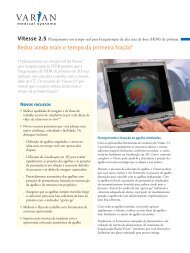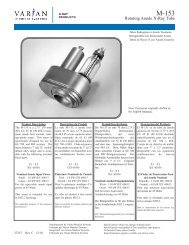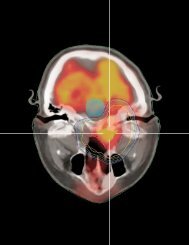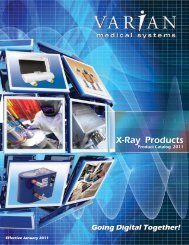Shell Darina SD 2 Grease - Varian
Shell Darina SD 2 Grease - Varian
Shell Darina SD 2 Grease - Varian
You also want an ePaper? Increase the reach of your titles
YUMPU automatically turns print PDFs into web optimized ePapers that Google loves.
Material Safety Data Sheet<br />
<strong>Shell</strong> <strong>Darina</strong> <strong>Grease</strong> <strong>SD</strong> 2<br />
Version 1.0<br />
Effective Date 04/12/2010<br />
according to EC directive 2001/58/EC<br />
1. IDENTIFICATION OF THE SUBSTANCE/PREPARATION AND COMPANY/UNDERTAKING<br />
Material Name : <strong>Shell</strong> <strong>Darina</strong> <strong>Grease</strong> <strong>SD</strong> 2<br />
Uses : Automotive and industrial grease.<br />
Product Code : 001B3406<br />
Manufacturer/Supplier : Compañía Distribuidora S.A (CODISA)<br />
Boulevard Industrial Norte No. 440 El Na<br />
Guatemala<br />
Guatemala<br />
Telephone : 502 24293900<br />
Fax : 502 2436 7263<br />
Emergency Telephone<br />
Number<br />
: 502 2436 7121<br />
2. COMPOSITION/INFORMATION ON INGREDIENTS<br />
Preparation description : A lubricating grease consisting of highly-refined mineral oil and<br />
additives.<br />
Hazardous Components<br />
Chemical Identity CAS EINECS Symbol(s) R-phrase(s) Conc.<br />
Benzenamine, Nphenyl-,<br />
reaction<br />
products with<br />
2,4,4trimethylpentene<br />
68411-46-1 270-128-1<br />
R52/53 1,00 - 5,00 %<br />
Additional Information : The highly refined mineral oil contains
Material Safety Data Sheet<br />
Safety Hazards : Not classified as flammable but will burn.<br />
Environmental Hazards : Not classified as dangerous for the environment.<br />
4. FIRST AID MEASURES<br />
<strong>Shell</strong> <strong>Darina</strong> <strong>Grease</strong> <strong>SD</strong> 2<br />
Version 1.0<br />
Effective Date 04/12/2010<br />
according to EC directive 2001/58/EC<br />
General Information : Not expected to be a health hazard when used under normal<br />
conditions.<br />
Inhalation : No treatment necessary under normal conditions of use. If<br />
symptoms persist, obtain medical advice.<br />
Skin Contact : Remove contaminated clothing. Flush exposed area with water<br />
and follow by washing with soap if available. If persistent<br />
irritation occurs, obtain medical attention. When using high<br />
pressure equipment, injection of product under the skin can<br />
occur. If high pressure injuries occur, the casualty should be<br />
sent immediately to a hospital. Do not wait for symptoms to<br />
develop. Obtain medical attention even in the absence of<br />
apparent wounds.<br />
Eye Contact : Flush eye with copious quantities of water. If persistent<br />
irritation occurs, obtain medical attention.<br />
Ingestion : In general no treatment is necessary unless large quantities<br />
are swallowed, however, get medical advice.<br />
Advice to Physician : Treat symptomatically. High pressure injection injuries require<br />
prompt surgical intervention and possibly steroid therapy, to<br />
minimise tissue damage and loss of function. Because entry<br />
wounds are small and do not reflect the seriousness of the<br />
underlying damage, surgical exploration to determine the<br />
extent of involvement may be necessary. Local anaesthetics or<br />
hot soaks should be avoided because they can contribute to<br />
swelling, vasospasm and ischaemia. Prompt surgical<br />
decompression, debridement and evacuation of foreign<br />
material should be performed under general anaesthetics, and<br />
wide exploration is essential.<br />
5. FIRE FIGHTING MEASURES<br />
Clear fire area of all non-emergency personnel.<br />
Specific Hazards : Hazardous combustion products may include: A complex<br />
mixture of airborne solid and liquid particulates and gases<br />
(smoke). Carbon monoxide. Unidentified organic and inorganic<br />
compounds.<br />
Suitable Extinguishing : Foam, water spray or fog. Dry chemical powder, carbon<br />
Media<br />
dioxide, sand or earth may be used for small fires only.<br />
Unsuitable Extinguishing : Do not use water in a jet.<br />
Media<br />
Protective Equipment for<br />
Firefighters<br />
6. ACCIDENTAL RELEASE MEASURES<br />
: Proper protective equipment including breathing apparatus<br />
must be worn when approaching a fire in a confined space.<br />
Avoid contact with spilled or released material. For guidance on selection of personal protective<br />
equipment see Chapter 8 of this Material Safety Data Sheet. See Chapter 13 for information on<br />
disposal. Observe all relevant local and international regulations.<br />
2/7<br />
Print Date 04/16/2010 M<strong>SD</strong>S_GT
Material Safety Data Sheet<br />
<strong>Shell</strong> <strong>Darina</strong> <strong>Grease</strong> <strong>SD</strong> 2<br />
Version 1.0<br />
Effective Date 04/12/2010<br />
according to EC directive 2001/58/EC<br />
Protective measures : Avoid contact with skin and eyes. Use appropriate containment<br />
to avoid environmental contamination. Prevent from spreading<br />
or entering drains, ditches or rivers by using sand, earth, or<br />
other appropriate barriers.<br />
Clean Up Methods : Shovel into a suitable clearly marked container for disposal or<br />
reclamation in accordance with local regulations.<br />
7. HANDLING AND STORAGE<br />
General Precautions : Use local exhaust ventilation if there is risk of inhalation of<br />
vapours, mists or aerosols. Properly dispose of any<br />
contaminated rags or cleaning materials in order to prevent<br />
fires. Use the information in this data sheet as input to a risk<br />
assessment of local circumstances to help determine<br />
appropriate controls for safe handling, storage and disposal of<br />
this material.<br />
Handling : Avoid prolonged or repeated contact with skin. Avoid inhaling<br />
vapour and/or mists. When handling product in drums, safety<br />
footwear should be worn and proper handling equipment<br />
should be used.<br />
Storage : Keep container tightly closed and in a cool, well-ventilated<br />
place. Use properly labelled and closeable containers. Storage<br />
Temperature: 0 - 50°C / 32 - 122°F<br />
Recommended Materials : For containers or container linings, use mild steel or high<br />
density polyethylene.<br />
Unsuitable Materials : PVC.<br />
Additional Information : Polyethylene containers should not be exposed to high<br />
temperatures because of possible risk of distortion.<br />
8. EXPOSURE CONTROLS/PERSONAL PROTECTION<br />
Occupational Exposure Limits<br />
Material Source Type ppm mg/m3 Notation<br />
Oil mist, mineral ACGIH TWA<br />
[Mist.]<br />
5 mg/m3<br />
ACGIH STEL<br />
[Mist.]<br />
10 mg/m3<br />
Additional Information : Due to the product's semi-solid consistency, generation of<br />
mists and dusts is unlikely to occur.<br />
Exposure Controls : The level of protection and types of controls necessary will vary<br />
depending upon potential exposure conditions. Select controls<br />
based on a risk assessment of local circumstances.<br />
Appropriate measures include: Adequate ventilation to control<br />
airborne concentrations. Where material is heated, sprayed or<br />
mist formed, there is greater potential for airborne<br />
concentrations to be generated.<br />
Personal Protective : Personal protective equipment (PPE) should meet<br />
Equipment<br />
recommended national standards. Check with PPE suppliers.<br />
Respiratory Protection : No respiratory protection is ordinarily required under normal<br />
3/7<br />
Print Date 04/16/2010 M<strong>SD</strong>S_GT
Material Safety Data Sheet<br />
<strong>Shell</strong> <strong>Darina</strong> <strong>Grease</strong> <strong>SD</strong> 2<br />
Version 1.0<br />
Effective Date 04/12/2010<br />
according to EC directive 2001/58/EC<br />
conditions of use. In accordance with good industrial hygiene<br />
practices, precautions should be taken to avoid breathing of<br />
material. If engineering controls do not maintain airborne<br />
concentrations to a level which is adequate to protect worker<br />
health, select respiratory protection equipment suitable for the<br />
specific conditions of use and meeting relevant legislation.<br />
Check with respiratory protective equipment suppliers. Where<br />
air-filtering respirators are suitable, select an appropriate<br />
combination of mask and filter. Select a filter suitable for<br />
combined particulate/organic gases and vapours [boiling point<br />
>65°C(149 °F)].<br />
Hand Protection : Where hand contact with the product may occur the use of<br />
gloves approved to relevant standards (e.g. Europe: EN374,<br />
US: F739) made from the following materials may provide<br />
suitable chemical protection: PVC, neoprene or nitrile rubber<br />
gloves. Suitability and durability of a glove is dependent on<br />
usage, e.g. frequency and duration of contact, chemical<br />
resistance of glove material, glove thickness, dexterity. Always<br />
seek advice from glove suppliers. Contaminated gloves should<br />
be replaced. Personal hygiene is a key element of effective<br />
hand care. Gloves must only be worn on clean hands. After<br />
using gloves, hands should be washed and dried thoroughly.<br />
Application of a non-perfumed moisturizer is recommended.<br />
Eye Protection : Wear safety glasses or full face shield if splashes are likely to<br />
occur.<br />
Protective Clothing : Skin protection not ordinarily required beyond standard issue<br />
work clothes.<br />
Monitoring Methods : Monitoring of the concentration of substances in the breathing<br />
zone of workers or in the general workplace may be required to<br />
confirm compliance with an OEL and adequacy of exposure<br />
controls. For some substances biological monitoring may also<br />
Environmental Exposure<br />
Controls<br />
be appropriate.<br />
9. PHYSICAL AND CHEMICAL PROPERTIES<br />
: Minimise release to the environment. An environmental<br />
assessment must be made to ensure compliance with local<br />
environmental legislation.<br />
Appearance : Brown. Semi-solid at room temperature.<br />
Odour : Slight hydrocarbon.<br />
pH : Not applicable.<br />
Initial Boiling Point and<br />
Boiling Range<br />
: Data not available<br />
Dropping point : > 270 °C / 518 °F<br />
Flash point : > 150 °C / 302 °F (COC)<br />
Lower / upper Flammability : Typical 1 - 10 %(V) (based on mineral oil)<br />
or Explosion limits<br />
Auto-ignition temperature : > 320 °C / 608 °F<br />
Vapour pressure : < 0,5 Pa at 20 °C / 68 °F (estimated value(s))<br />
Density : Typical 900 kg/m3 at 15 °C / 59 °F<br />
Water solubility : Negligible.<br />
n-octanol/water partition<br />
coefficient (log Pow)<br />
: > 6 (based on information on similar products)<br />
Kinematic viscosity : Not applicable.<br />
4/7<br />
Print Date 04/16/2010 M<strong>SD</strong>S_GT
Material Safety Data Sheet<br />
Vapour density (air=1) : > 1 (estimated value(s))<br />
Evaporation rate (nBuAc=1) : Data not available<br />
10. STABILITY AND REACTIVITY<br />
Stability : Stable.<br />
Conditions to Avoid : Extremes of temperature and direct sunlight.<br />
Materials to Avoid : Strong oxidising agents.<br />
Hazardous<br />
Decomposition Products<br />
11. TOXICOLOGICAL INFORMATION<br />
<strong>Shell</strong> <strong>Darina</strong> <strong>Grease</strong> <strong>SD</strong> 2<br />
Version 1.0<br />
Effective Date 04/12/2010<br />
according to EC directive 2001/58/EC<br />
: Hazardous decomposition products are not expected to form<br />
during normal storage.<br />
Basis for Assessment : Information given is based on data on the components and the<br />
toxicology of similar products.<br />
Acute Oral Toxicity : Expected to be of low toxicity: LD50 > 5000 mg/kg , Rat<br />
Acute Dermal Toxicity : Expected to be of low toxicity: LD50 > 5000 mg/kg , Rabbit<br />
Acute Inhalation Toxicity : Not considered to be an inhalation hazard under normal<br />
conditions of use.<br />
Skin Irritation : Expected to be slightly irritating. Prolonged or repeated skin<br />
contact without proper cleaning can clog the pores of the skin<br />
resulting in disorders such as oil acne/folliculitis.<br />
Eye Irritation : Expected to be slightly irritating.<br />
Respiratory Irritation : Inhalation of vapours or mists may cause irritation.<br />
Sensitisation : Not expected to be a skin sensitiser.<br />
Repeated Dose Toxicity : Not expected to be a hazard.<br />
Mutagenicity : Not considered a mutagenic hazard.<br />
Carcinogenicity : Product contains mineral oils of types shown to be noncarcinogenic<br />
in animal skin-painting studies. Highly refined<br />
mineral oils are not classified as carcinogenic by the<br />
International Agency for Research on Cancer (IARC). Other<br />
components are not known to be associated with carcinogenic<br />
effects.<br />
Reproductive and<br />
: Not expected to be a hazard.<br />
Developmental Toxicity<br />
Additional Information : Used grease may contain harmful impurities that have<br />
accumulated during use. The concentration of such harmful<br />
impurities will depend on use and they may present risks to<br />
health and the environment on disposal. ALL used grease<br />
should be handled with caution and skin contact avoided as far<br />
as possible. High pressure injection of product into the skin<br />
may lead to local necrosis if the product is not surgically<br />
removed.<br />
12. ECOLOGICAL INFORMATION<br />
Ecotoxicological data have not been determined specifically for this product. Information given is<br />
based on a knowledge of the components and the ecotoxicology of similar products.<br />
Acute Toxicity : Poorly soluble mixture. May cause physical fouling of aquatic<br />
organisms. Expected to be practically non toxic: LL/EL/IL50 ><br />
100 mg/l (to aquatic organisms) (LL/EL50 expressed as the<br />
nominal amount of product required to prepare aqueous test<br />
5/7<br />
Print Date 04/16/2010 M<strong>SD</strong>S_GT
Material Safety Data Sheet<br />
<strong>Shell</strong> <strong>Darina</strong> <strong>Grease</strong> <strong>SD</strong> 2<br />
Version 1.0<br />
Effective Date 04/12/2010<br />
according to EC directive 2001/58/EC<br />
extract). Mineral oil is not expected to cause any chronic<br />
effects to aquatic organisms at concentrations less than 1 mg/l.<br />
Mobility : Semi-solid under most environmental conditions. Floats on<br />
water. If it enters soil, it will adsorb to soil particles and will not<br />
be mobile.<br />
Persistence/degradability : Expected to be not readily biodegradable. Major constituents<br />
are expected to be inherently biodegradable, but the product<br />
contains components that may persist in the environment.<br />
Bioaccumulation : Contains components with the potential to bioaccumulate.<br />
Other Adverse Effects : Product is a mixture of non-volatile components, which are not<br />
expected to be released to air in any significant quantities. Not<br />
expected to have ozone depletion potential, photochemical<br />
ozone creation potential or global warming potential.<br />
13. DISPOSAL CONSIDERATIONS<br />
Material Disposal : Recover or recycle if possible. It is the responsibility of the<br />
waste generator to determine the toxicity and physical<br />
properties of the material generated to determine the proper<br />
waste classification and disposal methods in compliance with<br />
applicable regulations. Do not dispose into the environment, in<br />
drains or in water courses.<br />
Container Disposal : Dispose in accordance with prevailing regulations, preferably to<br />
a recognised collector or contractor. The competence of the<br />
collector or contractor should be established beforehand.<br />
Local Legislation : Disposal should be in accordance with applicable regional,<br />
national, and local laws and regulations.<br />
14. TRANSPORT INFORMATION<br />
ADR<br />
This material is not classified as dangerous under ADR regulations.<br />
RID<br />
This material is not classified as dangerous under RID regulations.<br />
IMDG<br />
This material is not classified as dangerous under IMDG regulations.<br />
IATA (Country variations may apply)<br />
This material is not classified as dangerous under IATA regulations.<br />
15. REGULATORY INFORMATION<br />
The regulatory information is not intended to be comprehensive. Other regulations may apply to this<br />
material.<br />
EC Classification : Not classified as dangerous under EC criteria.<br />
EINECS : All components<br />
6/7<br />
Print Date 04/16/2010 M<strong>SD</strong>S_GT
Material Safety Data Sheet<br />
listed or polymer<br />
exempt.<br />
TSCA : All components<br />
listed.<br />
16. OTHER INFORMATION<br />
R-phrase(s)<br />
<strong>Shell</strong> <strong>Darina</strong> <strong>Grease</strong> <strong>SD</strong> 2<br />
Version 1.0<br />
Effective Date 04/12/2010<br />
according to EC directive 2001/58/EC<br />
R52/53 Harmful to aquatic organisms, may cause long-term adverse effects in the<br />
aquatic environment.<br />
M<strong>SD</strong>S Version Number<br />
: 1.0<br />
M<strong>SD</strong>S Effective Date : 04/12/2010<br />
M<strong>SD</strong>S Revisions : A vertical bar (|) in the left margin indicates an amendment<br />
from the previous version.<br />
M<strong>SD</strong>S Regulation : The content and format of this safety data sheet is in<br />
accordance with Commission Directive 2001/58/EC of 27 July<br />
2001, amending for the second time Commission Directive<br />
91/155/EEC.<br />
M<strong>SD</strong>S Distribution : The information in this document should be made available to<br />
all who may handle the product.<br />
Disclaimer : This information is based on our current knowledge and is<br />
intended to describe the product for the purposes of health,<br />
safety and environmental requirements only. It should not<br />
therefore be construed as guaranteeing any specific property<br />
of the product.<br />
7/7<br />
Print Date 04/16/2010 M<strong>SD</strong>S_GT


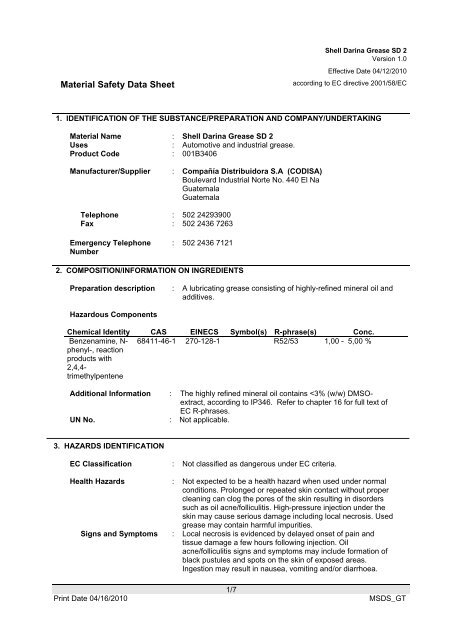

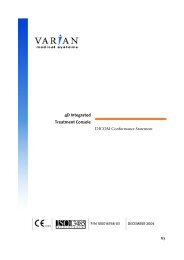

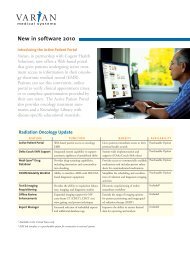
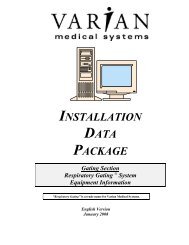
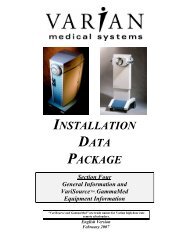
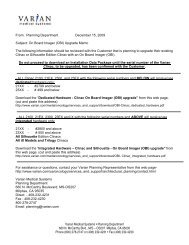
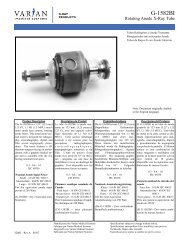
![[MSDS 126] Dow Corning 200 Fluid, 5 CST Part Number ... - Varian](https://img.yumpu.com/5104917/1/190x245/msds-126-dow-corning-200-fluid-5-cst-part-number-varian.jpg?quality=85)


